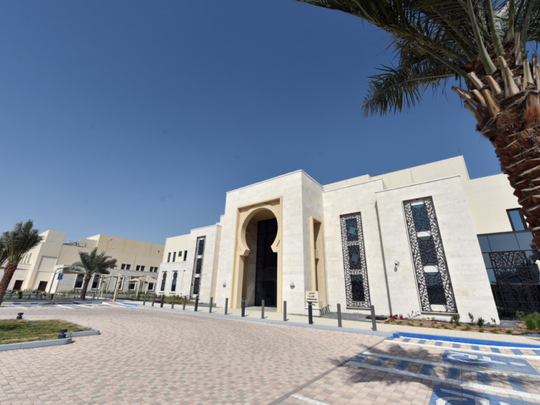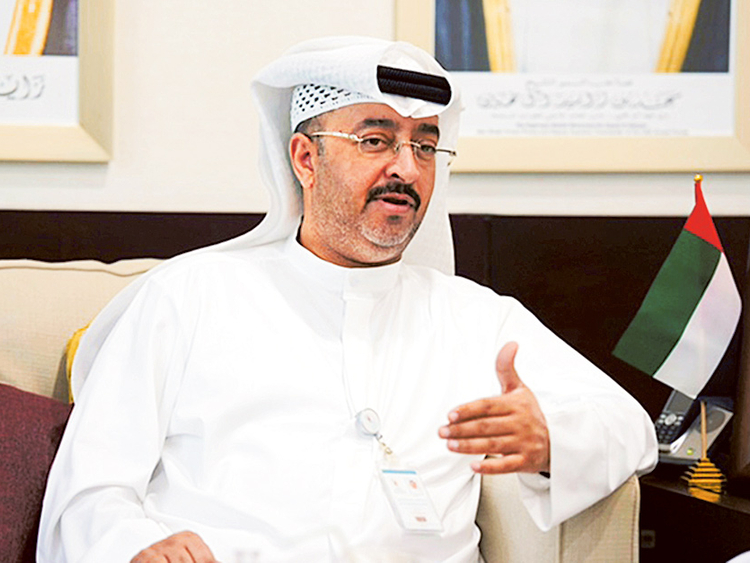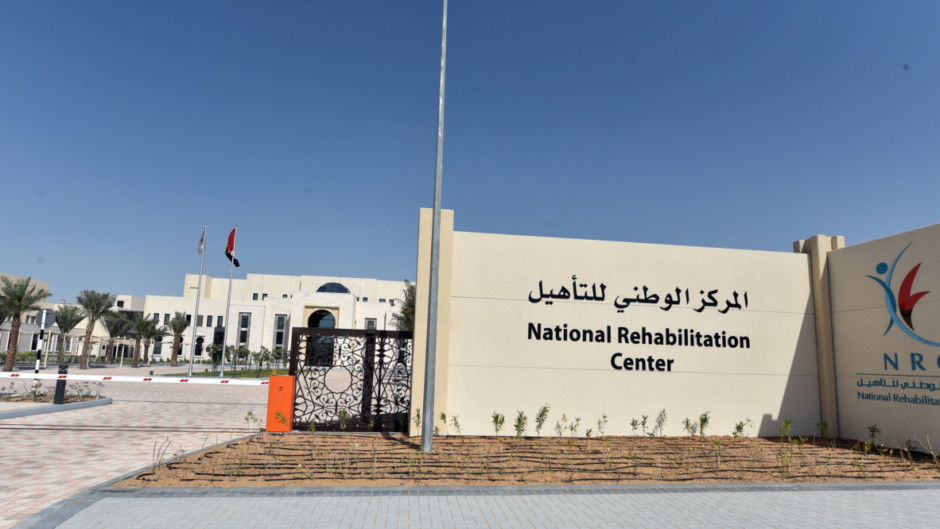
Abu Dhabi: In a span of 17 years, the National Rehabilitation Centre (NRC) has grown from just an idea of UAE’S founding father Shaikh Zayed Bin Sultan Al Nahyan to a regionally respected and internationally recognised centre for treatment of various addiction challenges. From an initial small cohort of trained staff who came from abroad, to a beacon of training locals with well established graduate programmes with internationally accredited institutions. the NRC has taken huge strides and is now moving to the new permanent headquarters in Shakhbout City, near Al Mafraq Hospital. Built at a cost of Dh285 million, it spreads over an area of over 100,000 square metres.
Gulf News met Dr Hamad Al Gaferi, Director-General of the National Rehabilitation Centre, to tell us more about NRC and its plans.
How has the centre progressed since it opened in 2000?
We are very proud of the centre. It has managed to evolve to this stage thanks to the support of Shaikh Mansour Bin Zayed Al Nahyan, [Deputy Prime Minister and Minister of Presidential Affairs] who has been supporting and following the centre since the year 2000.
Back in the year 2000, the centre was just mainly an idea. At that time, Shaikh Zayed ordered the establishment of a small place to take of narcotic addicts, and he supported us through the Presidential Office at that time. In the space of 17 years, we have progressed a lot — we currently have a big hospital, with many clinics, outpatient departments, and a new building with 169 beds.
NRC currently operates two centres in Abu Dhabi city and Shaikh Khalifa City, which together offer 78 beds.
We are currently in the second stage of our development; the first stage was to establish and continue the centre’s growth, the second stage is to focus different areas such as rehab and research. The most important direction is the research.
How have attitudes changed from 17 years ago?
In 2002, we had 30 addicts. At that time, society’s idea about addicts was very negative, so it was difficult for an addict to come to us because of the stigma attached to them. We had to go to them and convince them to come and get free treatment at the centre, and it was difficult to convince them.
Since 2002, we have registered 2,400 cases. 75 per cent of these people asked for the treatment themselves, and the other 25 per cent were brought from the Ministry of Interior, these were people who were arrested and brought in by the ministry to give them help.
In 2002, in the first six months, we had only one patient because society was not ready to deal with this issue. Now, we have 78 beds, and we are currently moving to our new building and centre which will have 169 beds.
In most of the cases we have received, the addicts were between the ages of 20-30. There were some cases when the addicted person was only 13 or 14 years old. In some instances, we also had patients above 60 years of age.
The addicts who did come to the centre for rehabilitation were worried from 2 things — the shame from society, and the law. They thought that they would be under the punishment of the law. We convinced them that addicted people are not to be treated like suspects or criminals, they are patients who need help. Over time, slowly, the idea started to change, but it took many years for this change in society.
How has the centre evolved in how it treats its patients?
In the beginning, all the addicts were treated in one section, so addictions to heroin, hashish, alcohol, tablets, were in one section. Now, we divide each substance addiction into a separate section — we separate the alcohol addiction from heroin, for example.
What about the human resources sources working at the centre?
From the beginning we have placed a strong focus on developing human resources — specialists, doctors, nurses, and social workers. We sent them for many courses inside and outside the country to be well prepared to deal with patients, we also put a sharp focus on psychology, because this kind of specialist is rare, and this specialist can play a big role in helping the addicted person overcome his struggle. We also actively encourage Emiratis to pursue studies in the field of drug rehabilitation, because when you have people from the same society treating one another, it makes it easier.
We also have agreements and partnership with international centres in the same field from different countries, especially from the UK — such as the University of London. They helped us build our infrastructure. Another partnership we have is with McLean Hospital which is an affiliate of Harvard Medical School.
In 2008, we started to build our own infrastructure with a very big training programme to graduate specialists from the UAE in social science and nursing.
Were specialists brought in from abroad to help?
Yes, of course, because we do not have specialists from our people, and even in Arab countries, they are very rare in this field, so we brought many specialists from countries like the UK, US and others. We do have some Arab specialists working with us, but the specialists are mostly non-Arabs. We currently we have some female Emirati graduates in nursing, and they are doing well. It is important to make a distinction as well that nursing in the field of helping narcotic addicts is different and difficult, it’s not easy. It differs from normal nursing.
How do you prepare and train your staff at the centre?
First, we make sure that they are bilingual in both Arabic and English, we teach them both languages. After that, we have training sessions and workshops, the sessions are focused on narcotics addiction, we have an agreement with Kings College in London for training sessions as well.
In 2010, we finished 12 training sessions and the total number of training sessions we have carried out until now have been a total of 24 training sessions for all the staff with Kings College in London. Some of sessions have been done inside the UAE, and some in London. We have also made another agreement with the rehab centre at Kings College and UAE University to give bachelor degrees to the trainees.
Through this programme between Kings College and UAE University, we have four groups of graduates, most of them are from UAE, and others are from the GCC countries.
We also have a programme called Matrix, this programme focuses on how to deal with the a patient who is suffering from substance addiction. This programme session covers a total of 16 weeks, the programme focuses how to deal with substance addiction and how to get involved in the healing process, and how to make the addicted person accept the rehabilitation as well. We have five specialists from different countries currently in this programme.
Have Emiratis been willing to come work in this field?
We definitely want more Emiratis involved and we encourage them to do so. Many Emiratis don’t want to study nursing or go through this training to treat drug addicts. At the moment, we do have Emiratis working with us, and compared to when we started, the number is larger, so slowly we can see that attitudes are changing and more Emiratis are willing to work in this field as a career.
At present, we have six Emirati specialist nurses, one of them is a female with a PhD in the field of treating narcotics addicts. Our Emirati specialists are graduates of our successful programmes.
Can you tell us about your new agreement with Mclaine Hospital at Harvard University?
This agreement will be aimed at training specialists to handle and treat narcotic addiction in three stages. The first stage will be on preparing the addict for the detoxification, the second period will be to prepare the addict to accept the medicine, and if the first two stages are a success then it will be on preparing the healed addict on how to be a good person in society.
The first and second stage need specialists in medication, and the third stage needs specialists in psychology and social work.
Can you give us some information on your participation in the Colombian Plan?
The Colombian Plan is an umbrella of countries working together to come out with programmes and policies to counter narcotics and alcohol addiction. Through our participation in the Columbian Plan, we are able to exchange information, have training sessions, and exchange each others results. All of this contributes towards improving our own work and programmes.
In numbers
Dh5.5 billion
Economic cost of drug addiction in UAE each year (based on a study between 2012-2015).
2,400 cases
registered at NRC. 75% of these people asked for the treatment themselves while 25% were brought in by Ministry of Interior (these were people arrested).
2002
Only one patient in the first six months of NRC.
169
beds in new building, and 78 beds in two facilities currently.
20-30 years
Age of most people in need of NRC’s services. In some cases, addicts were only 13 or 14 years old.
New NRC building
Abu Dhabi General Services Company, Musanada, completed all the work related to the headquarters of the National Rehabilitation Centre, NRC, at Shakhbout City.
The new hospital and medication centre will establish and deliver health rehabilitation and community care facilities aimed at providing best rehabilitation and reform programmes in order to develop the potentials and capabilities of rehabilitated individuals so that they become active members of their community and positively contribute to the comprehensive development process witnessed by the UAE.
The news NRC building which began operations in June 2014, comprises seven buildings serving NRC’s objectives: the administration building, male outpatient rehabilitation building, female outpatient rehabilitation building, male assessment building, medical services building, multi-use building and the central station building.
NRC also includes a number of specialist clinics and facilities required to achieve optimal treatment results. It has a 169-bed capacity.
“The Dh285-million National Rehabilitation Centre has a built up area of approximately 50,000 square metres. Musanada has constructed the external works of NRC within the borders of the plot allocated for construction stretching over 100,000 square metres, including paving of roads and parking areas, as well as tree planting and landscaping for the various external spaces. Musanada has been keen on gearing all efforts to provide comfort and safety to NRC’s users, ensuring compliance with highest international and engineering standards while maintaining a sustainable system to preserve various resources.
Two challenges
Dr Hamad Al Gaferi, Director-General of the the National Rehabilitation Centre, saod that at the beginning there was a big challenge because “our society was not ready to accept a rehabilitation centre that helped drug addicts. A large majority of Emiratis did not believe that we had such a problem, they did not understand the reality”.
A second challenge was with the law — how did the law deal with these kind of cases pertaining to addiction, was the person a criminal or a victim? “We signed some agreements with the Ministry of Interior to look at these kind of cases — we have the victim, and the criminal, the people who are selling are the criminals and the people using are the victims, we said that only the addicted ones are the victims,” Al Gaferi said.









